EVGA X79 Dark Review
by Ian Cutress on October 23, 2013 10:00 AM EST- Posted in
- Motherboards
- Intel
- EVGA
- X79
Rightmark Audio Analyzer 6.2.5
In part due to reader requests, we are pleased to include Rightmark Audio Analyzer results in our benchmark suite. The premise behind Rightmark:AA is to test the input and output of the audio system to determine noise levels, range, harmonic distortion, stereo crosstalk and so forth. Rightmark:AA should indicate how well the sound system is built and isolated from electrical interference (either internally or externally). For this test we connect the Line Out to the Line In using a short six inch 3.5mm to 3.5mm high-quality jack, turn the OS speaker volume to 100%, and run the Rightmark default test suite at 192 kHz, 24-bit. The OS is tuned to 192 kHz/24-bit input and output, and the Line-In volume is adjusted until we have the best RMAA value in the mini-pretest. We look specifically at the Dynamic Range of the audio codec used on board, as well as the Total Harmonic Distortion + Noise.
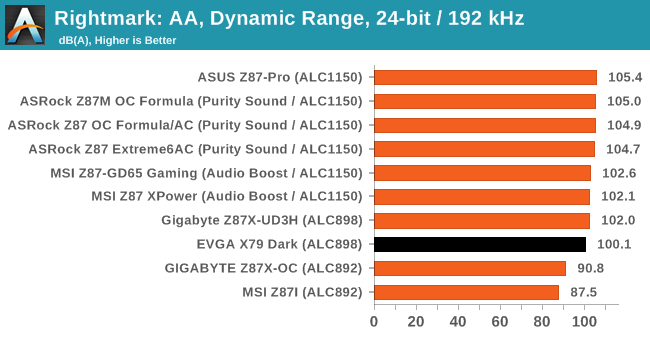
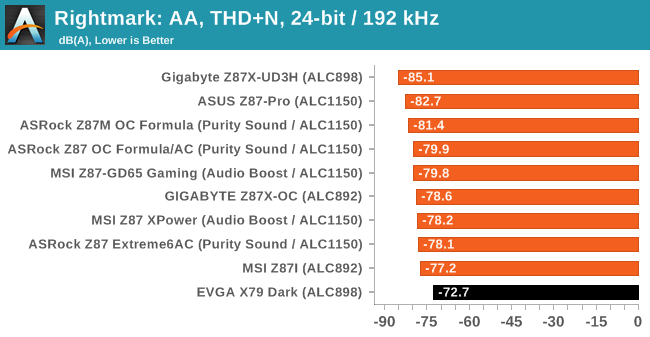
Using the Realtek ALC898 we see a dynamic range of over 100 dBA, although GIGABYTE squeezed more out of the codec than EVGA in terms of harmonic distortion levels.
USB Backup
For this benchmark, we run CrystalDiskMark to determine the ideal sequential read and write speeds for the USB port using our 240 GB OCZ Vertex3 SSD with a SATA 6 Gbps to USB 3.0 converter. Then we transfer a set size of files from the SSD to the USB drive using DiskBench, which monitors the time taken to transfer. The files transferred are a 1.52 GB set of 2867 files across 320 folders – 95% of these files are small typical website files, and the rest (90% of the size) are the videos used in the WinRAR test. In an update to pre-Z87 testing, we also run MaxCPU to load up one of the threads during the test which improves general performance up to 15% by causing all the internal pathways to run at full speed.
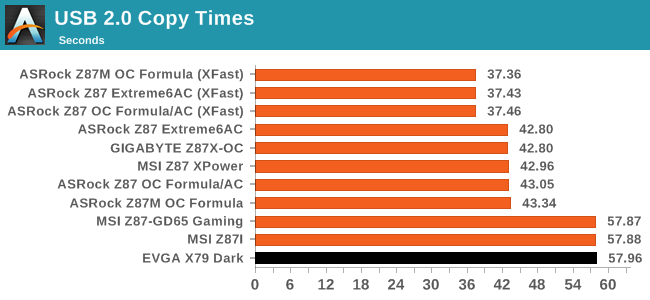
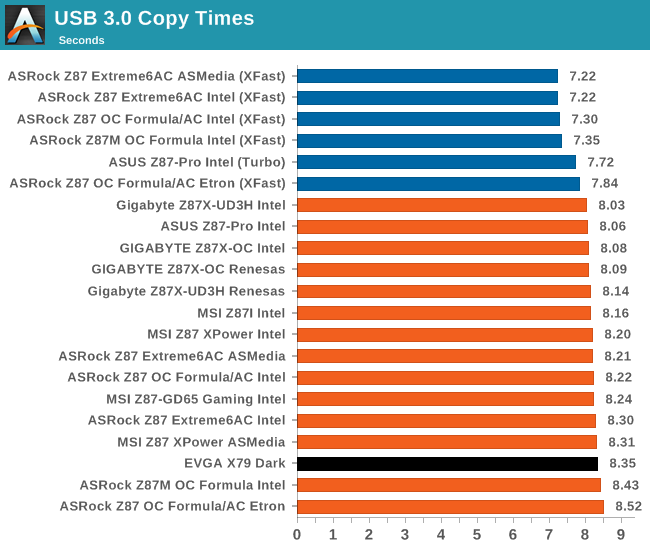
The EVGA X79 Dark, being on the older chipset, cannot keep up pace with the newer chipsets and optimizations.
DPC Latency
Deferred Procedure Call latency is a way in which Windows handles interrupt servicing. In order to wait for a processor to acknowledge the request, the system will queue all interrupt requests by priority. Critical interrupts will be handled as soon as possible, whereas lesser priority requests, such as audio, will be further down the line. So if the audio device requires data, it will have to wait until the request is processed before the buffer is filled. If the device drivers of higher priority components in a system are poorly implemented, this can cause delays in request scheduling and process time, resulting in an empty audio buffer – this leads to characteristic audible pauses, pops and clicks. Having a bigger buffer and correctly implemented system drivers obviously helps in this regard. The DPC latency checker measures how much time is processing DPCs from driver invocation – the lower the value will result in better audio transfer at smaller buffer sizes. Results are measured in microseconds and taken as the peak latency while cycling through a series of short HD videos - under 500 microseconds usually gets the green light, but the lower the better.
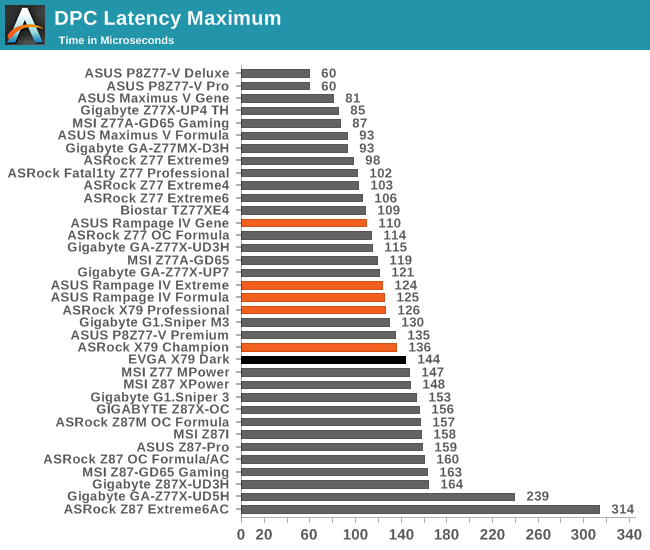
With Z87’s reluctance to have a peak DPC Latency less than 150 microseconds, it falls on Ivy Bridge to be the backup. The EVGA falls just under that 150 target.










23 Comments
View All Comments
Flunk - Friday, October 25, 2013 - link
I can't see why anyone would buy this. EVGA might be a top-tier video card supplier but their motherboards are seriously unproven and generally problematic. Unless they prove a real cut-rate price I can't see sales coming their way. And even that, in the high-end, probably doesn't matter. I would literally pay $150 more for the Rampage Formula than for this.mapesdhs - Friday, October 25, 2013 - link
Alas I have to agree. Seems odd to release a board like this now which has so many
problems when there are alternatives such as the awesomely reliable and easy to use
range from ASUS which won't cause any grief. You mentioned the Formula; there's
also the Extreme, though I bought the P9X79 WS which has identical functions as
regards oc'ing, etc. I had no problems getting mine to 4.7 with a 3930K, 64GB RAM
@ 2133, _four_ GTX 580 3GB cards, several SSDs, disks, etc. See:
http://valid.canardpc.com/zk69q8
And I haven't remotely finished pushing the CPU oc yet.
It's a pity, I do some have nice older EVGA boards, but this release seems so out of whack.
Ian.
wakuritz - Monday, October 28, 2013 - link
Not nit-picking, just pointing out the grammatical error in the 2nd paragraph, last sentence (manufacturer<manufactures): "A BIOS is always just ones and zeroes, and it is up to the company who manufacturer the motherboard to get the BIOS to work first time, even on the simple stuff."Good review, as expected. Thanks, Ian.